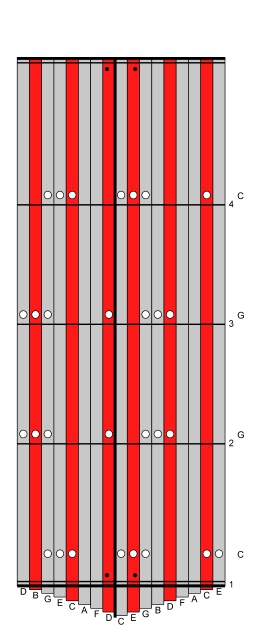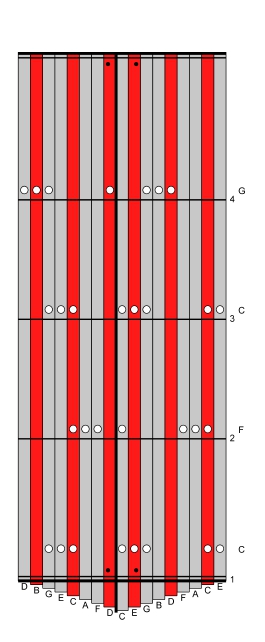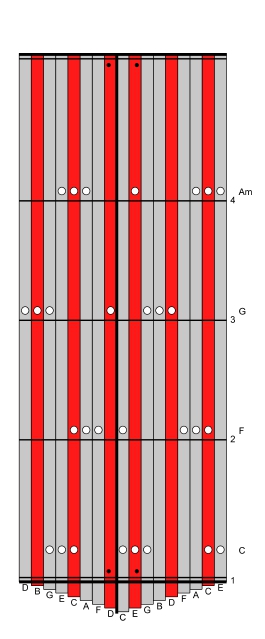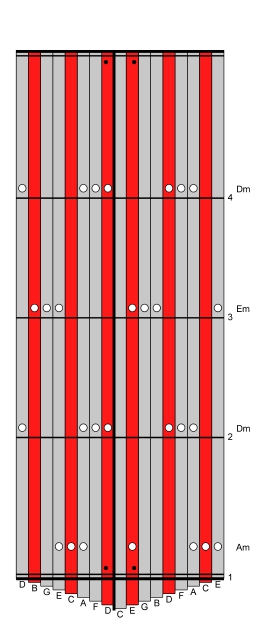Hey, get out your 17-Note kalimba in C and jam along with these simple chord progressions.
We show you the chord progression and the notes in each chord, and we give you a sound file that embodies that chord progression. This is a fun way to learn how to jam on your kalimba.
When most people think of improvisation, they tend to think of just making things up and going wild. However, most compositions, and also the best improvisations, follow rules. Different rules will make different types of music.
The most important rule that I follow when I write music or improvise music is that I create a melody that follows an underlying chord progression. In this post, I supply recordings of four different chord progressions that you can play along to. For each one, I show you what kalimba notes are in each chord, and I also provide a recording of my improvising on kalimba along with the backing track, to give you ideas of what you can do.
In other words, jam along!
Below, I show you how to play along with four common chord progresisons. The tablature on the left spells out the notes in each chord. These will all be safe notes when that chord is playing, but of course, you can play any note at any time, it is all up to how play them. While I play many that that are not in the chord of the moment, I tend to de-emphasize them by playing them fleetingly, on weak beats.
As you play along with a chord progression, listen to hear when the chord changes. Keep aware of what chord is playing at each time. For all of these backing tracks, I am playing in simple 4/4 time. Chord changes only happen at the start of a measure. Generally each chord will last one measure or 4 beats, though for the first progression, the chords last two measures, or 8 beats.
The simple chord progressions below are each repeated several times so you can really get into the groove. Be in your head, thinking of the details of the chords, as long as you need to be. Eventually, you will hear the chord changes subconsiously, and after a long time, your thumbs will just know where to go and when. I love it when I get to that place, because then I can let go and allow myself to connect to heart-centered music. Until then, be thankful you have a good brain that can follow these details and help you practice.

||: C | G | G | C :||
This is at once the most famous and important chord progression in western music, and the simplest chord progression. In terms of Roman numerals, it is:
||: I | V | V | I :||
That is, it starts out on the root chord, the I chord, which is C, and then goes off to the V chord, the G. The V chord drives us back home to the I chord on the repeat. Note that when we repeat the phrase, the last chord, C, joins with the first chord, C, of the next repeat, to form two measures of the C chord. Try to phrase your playing to suggest an ending for the 4th measure C, and to suggest a beginning when playing the next measure 1.
Backing Track:
With Example Kalimba

||: C | F | C | G :||
This progression is a cliche in both western pop music and in African music. “The Lion Sleeps Tonight” uses this progression and is an example of both genres. In terms of Roman numerals, it is:
||: I | IV | I | V :||
The root, or home chord is established first, and the first “away” chord is the IV chord. Then back home and finally to the V chord that pushes us home again on the repeat. This is one of the most fun things you can do on kalimba.
Back Track:
With Example Kalimba

||: C | F | G | A min :||
The first two progressions used only major chords. “C” or “G” mean “C major” and “G major.” We also see the A minor chord (A min). In Roman numerals, minor chords are represented as lower case letters, and major chords are represented by capital letters:
||: I | IV | V | vi :||
This one starts out as a “I – IV – V” – pronounced “one four five” – a very famous progression, and essentially similar to the previous progression. Most “I – IV – V” progressions head back to the I chord. The end of this progression has its own name – it is called a “deceptive cadence” – when you hit G, the V chord, all indications are that the progression will go back to C, the I chord. However, the progression slides up to the A minor instead.
Back Track:
With Example Kalimba

||: A min | D min | E min | D min :||
I love minors on the kalimba. Your kalimba is probably set up to emphasize C – it is the lowest note. When you pick up your C major kalimba, you just tend to play in C major. But there are several different scales you can play, each with its own flavor, simply by starting on a different note. Find your A tines, play some A minor chords, and ignore those lowest notes for a while. Reset your mind to A minor.
This chord progression is the minor version of the “one four five.” If we write the Roman numerals relative to C major = I, we get:
||: vi | ii | iii | ii :|| (if C = I)
But we can redefine the root note to be A. If we do, we are then in A minor. Shifting that reference frame, we can think of the progression as:
||: i | iv | v | iv :|| (if Am = i)
A really cool thing happens at the end of this piece – I switch from an E minor to an E major (that is with a G#). And to play along with that, I put down my standard C tuned kalimba and pick up my Middle Eastern tuned kalimba – doesn’t it sound fantastic? You might want to check out the Middle Eastern tuned kalimba.
Back Track:
With Example Kalimba


Sign up for our newsletter and free resources with your email address:
We pinky promise not to spam you and to only send good stuff.
 Christmas in July 2025
Christmas in July 2025 Patriotic and American Music for Kalimba
Patriotic and American Music for Kalimba